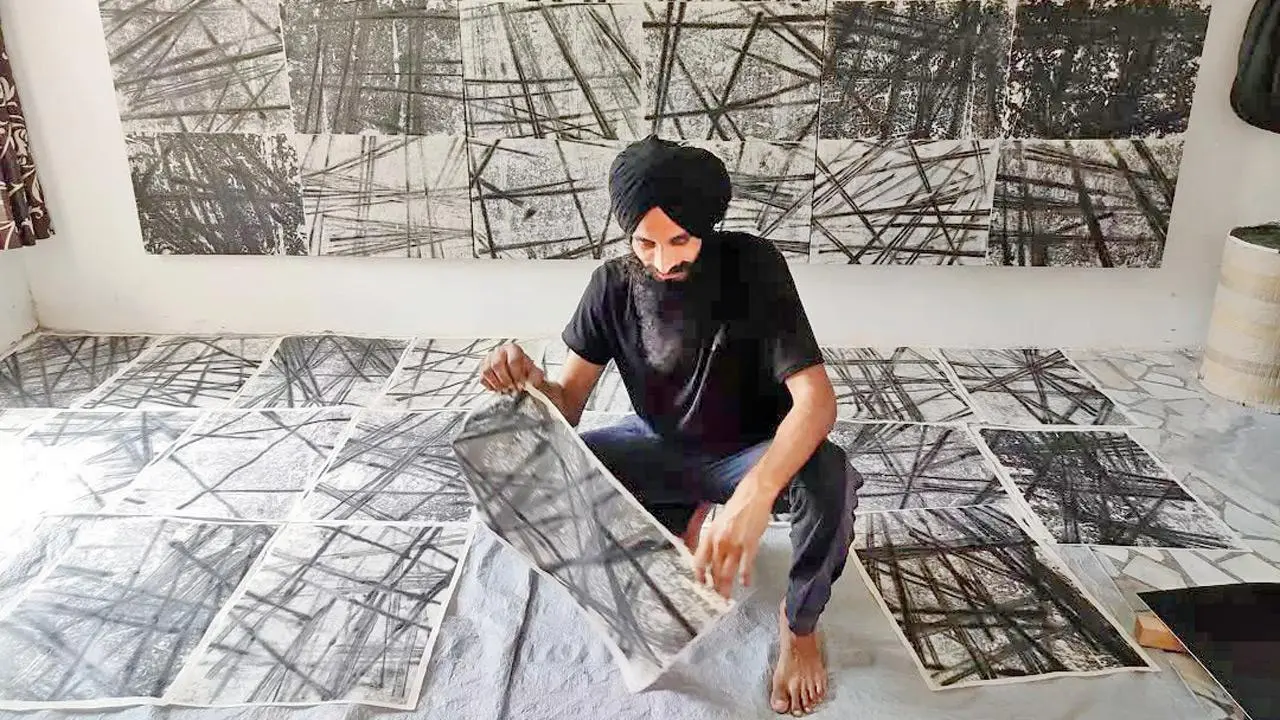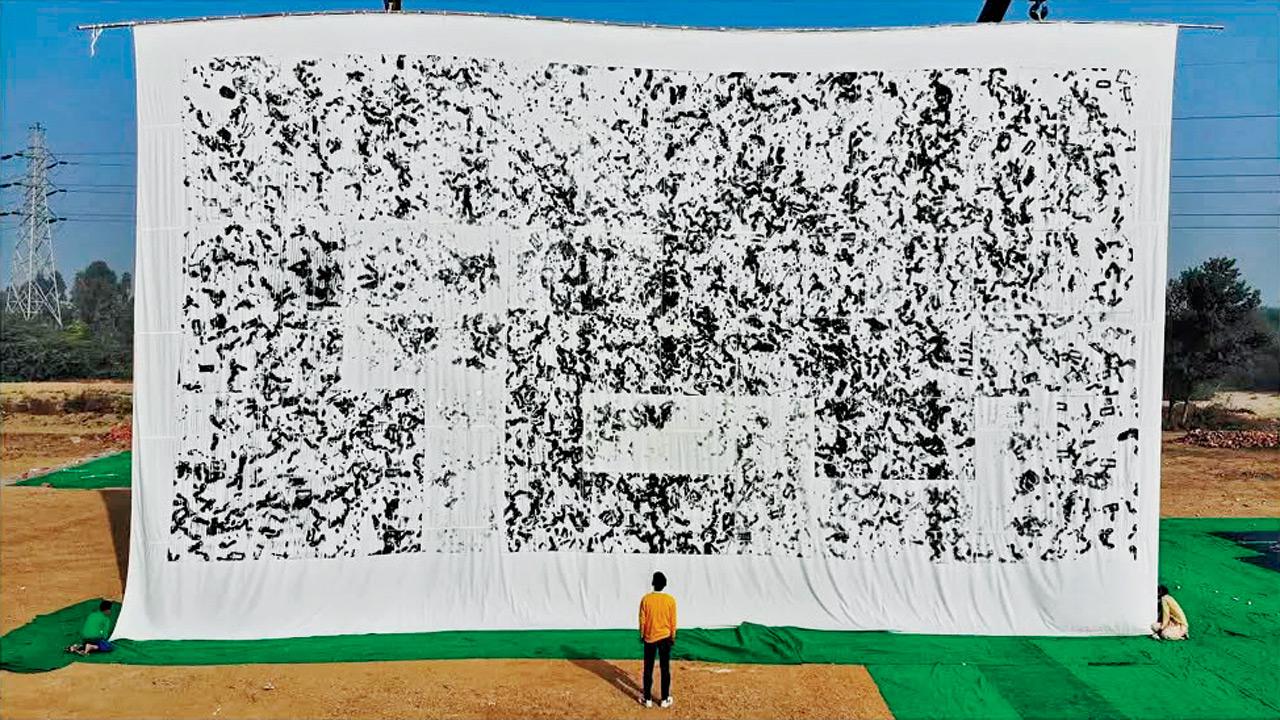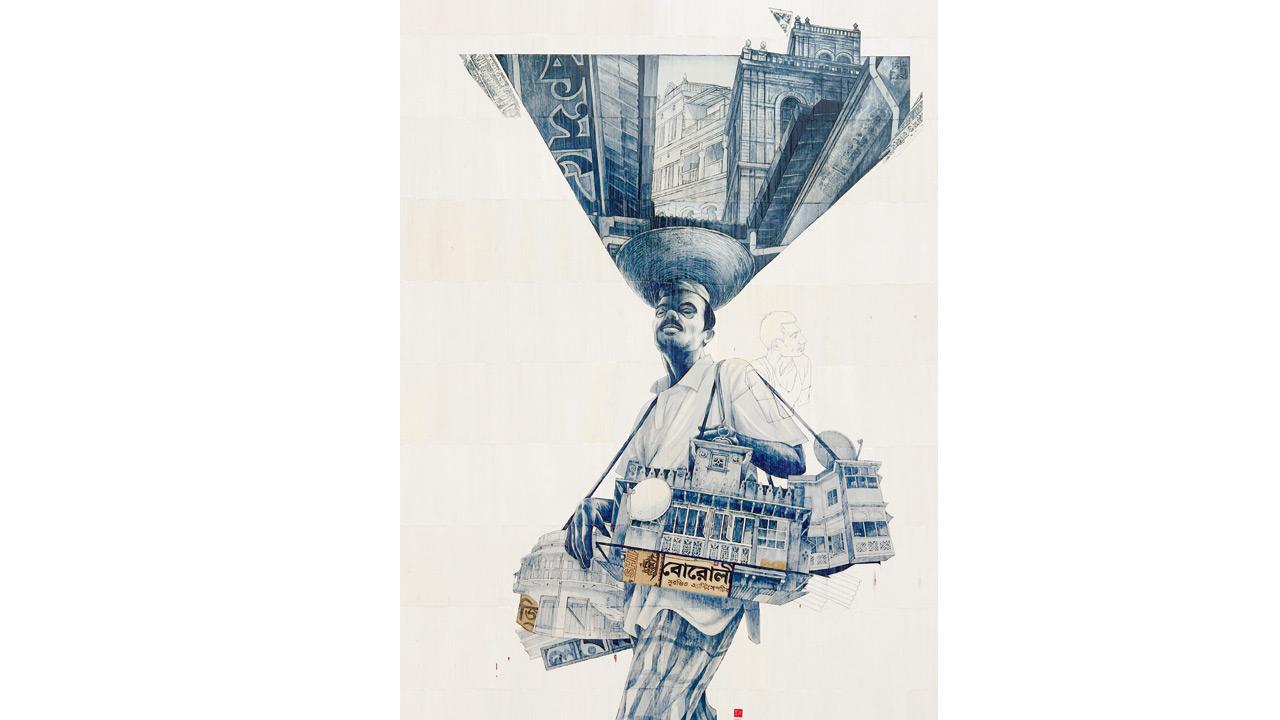Art has always reflected society, and artists are getting louder about depleting nature and the increasing pollution around us

Kulpreet Singh working on his series Indelible Black Marks
An artist is a sensitive person… If a sensitive person doesn’t feel, who will?” asks Kulpreet Singh, a Patiala-based visual artist, whose series, Indelible Black Marks, highlights the effects of the stubble burning practice in the farmlands of Punjab.
Singh’s series conceptually reflects on the permanent black marks carved onto our ecosystem through practices farmers have been forced to take up. He dragged massive canvases through the burning fields in his homeland, allowing the stubble to leave impressions like scars on the earth. The series was also showcased at the JSW Earth Care Awards 2025 in Mumbai.
Speaking about his work, Sangita Jindal, chairperson of JSW Foundation says, “Recognising him through the Earth Care Awards is a reminder that addressing climate change is not just about science and technology; it is about empathy, creativity, and collaboration across all walks of life.”

Kulpreet Singh’s Indelible Black Marks
While artists have often used their canvases for activism, the environmental crisis and messages about climate change are increasing. At Nature Morte, the contemporary art gallery that sits inside the historic Dhanraj Mahal in Colaba, Vibha Galhotra’s works are on show. A visual artist known for her environmental themes, Galhotra’s solo exhibit titled Solastalgia: The Weight in the Air, focuses on the distress caused by environmental changes.
Some steps away in Kala Ghoda, Method, art gallery’s Nature of Us, a group exhibition, explores the paradoxical relationship between humans and the environment.
Why are we seeing the art world speak of the environment crisis so much? Founder and curator of Method Sahil Arora says, “Growing up in a city like Mumbai, ‘nature’ is almost a foreign concept. We’ve lived quite removed from it; it’s never been deeply integrated into my life. I think because of this distance, it felt like a theme worth exploring.”
Galhotra began exploring ecological themes after she realised, around 2009, that the stinky drain she crossed daily was the heavily polluted Yamuna, once a cherished part of her childhood. She began photographing it, and subsequently she met a man who had come for a holy dip. “I tried to stop him, telling him it was like a cesspool, but he went ahead,” she says. This prompted her to use the muck from the riverbed on her canvases.
At Nature of Us, you see a host of expressions of the environment. Kolkata-based artist Jit Chowdhury’s Urban Soul uses Bengal-rooted materials like shola (Indian cork or pith), natural indigo, and recycled paper to depict the concrete jungle overtaking our lives, where nature is a getaway, not a given. “I’m trying to show the city as soulless; and I tend to show less of nature, almost none, in my work — as a slap that we are losing it,” he explains.

Urban Soul VI, an artwork by Jit Chowdhury
Baroda-based Keerti Pooja’s watercolours explore human rituals with nature, while Delhi-based Prasoon Poddar’s tea kettle series honours everyday conversations and urges us to pause, reflect, and reconnect with nature.
Explaining why it is crucial to depict environmental themes, Poddar says, “Earlier, elders had rituals and stories which didn’t allow you to cut a banyan or a peepal tree. Either it was because of God or because a spirit was believed to reside in the tree. Whatever the reason, it made us leave trees as they are, and not chop them down. We don’t have that any more.”
“Art, after all, has a unique way of reaching us. While data and reports can inform, it is often a painting, a performance, or an installation that moves us to act,” says Jindal. It almost seems like an artist cannot simply be an artist any more, and environmental changes have pushed them to the edge. Many have turned activists, too. But Chowdhury says it’s not new. “We are the voices. Every sector, every group plays different roles. We are the vocal cords.”
For most, putting out such messages in their art is not about raising awareness. It’s simply a way to question, reflect, and to push audiences to reflect as well. So, will art ever bring about behavioural change?
Chowdhury says that design and art always play with emotions. “It has happened with the national flag. Nowhere is it written that you have to get goosebumps looking at the flag, yet people do throughout the world. People are moving mountains looking at that design. If I take that as a piece of design, it’s one of the loudest designs ever made.”
Singh cites Picasso’s Guernica as an example of art activism. This anti-war painting was a response to the bombing of Guernica in northern Spain during the Spanish Civil War, and reportedly caused world leaders to pause and reconsider.
However, Singh’s work has helped prevent violence as well. During the farmers’ protest, he staged a performance called Stone Pelting, where farmers threw stones — first rubbed on carbon paper — onto cloth to create impressions. “I then showed it to the farmers, explaining to them that if the protest turned violent, it would be of no use. If they resorted to pelting, they would have already lost,” he says. Later, children at the Tikri border who had participated told him, “Hum stone pelter toh nahi banengey (we will not become stone pelters).”
Does this mean galleries can be a place of learning and conveying messages? Arora says they could, but adds, “I wouldn’t say anything is a gallery’s responsibility to address or not. Every gallery and curator creates exhibitions that speak to them. Besides, even if we see 100 shows addressing environmental issues are we going to make any tangible difference? Probably not. Does that also mean galleries should avoid environmental issues? Not at all.”
 Subscribe today by clicking the link and stay updated with the latest news!" Click here!
Subscribe today by clicking the link and stay updated with the latest news!" Click here!








